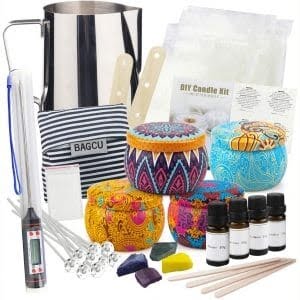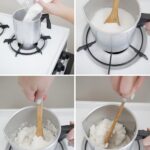Candle making is a popular hobby that allows enthusiasts to create beautiful and functional pieces of art. At the heart of every candle is the wick, which plays a crucial role in the burning process. In this article, we will dive into the fascinating world of candle wick making candles, exploring its history, science, and practical applications.
The history of candle making dates back thousands of years, with evidence of early civilizations using candles for light and religious ceremonies. The wick has always been an essential component of candles, as it serves as the conduit for the fuel (wax) to be drawn up and burned. Understanding the different types of candle wicks and their uses is crucial for creating candles that burn efficiently and produce a pleasing flame.
Delving into the science behind candle wick making allows us to grasp the mechanics of how wicks function and how they interact with various types of wax. By understanding these principles, we can create custom-made candle wicks tailored to specific candle-making projects. In the following sections, we will explore step-by-step guides for making your own candle wicks, as well as tips and tricks for successful candle wick making.
History of Candle Making and Importance of the Wick
Candle making dates back centuries, with evidence of candles being used in ancient civilizations such as the Egyptians and Romans. The importance of the wick in candle making cannot be overstated, as it is responsible for the combustion process that allows the candle to produce light. In the early days, candle wicks were made from materials such as twisted linen or cotton fibers, which were dipped in tallow or beeswax to create a burning flame.
As technology advanced, different types of wicks were developed to suit various candle-making needs. The development of braided cotton wicks allowed for cleaner and more efficient burning, while the introduction of zinc core wicks improved stability and reduced “mushrooming” at the top of the candle. Today, candle makers have access to a wide range of wick options, including those made from wood, metal, and even paper.
The history of candle making and the evolution of candle wicks have paved the way for modern enthusiasts to explore their creativity in making custom candles. Understanding the role of the wick in a candle’s performance is essential when creating handmade candles. With this knowledge, crafters can experiment with different types of wicks to achieve specific burn times, fragrance throw, and aesthetic appeal in their homemade candles.
Different Types of Candle Wicks and Their Uses
When it comes to candle wick making, choosing the right type of wick is crucial for the successful burning of a candle. There are various types of candle wicks, each designed for specific uses and candle types. Understanding the different types of candle wicks and their uses can help you create candles that burn cleanly and evenly.
One of the most common types of candle wicks is the cotton wick. Cotton wicks are known for their clean burn and minimal soot production, making them ideal for container candles. They come in different sizes to accommodate various container diameters, ensuring proper wax pool formation and an even burn.
Another popular type of candle wick is the wood wick. Wood wicks provide a unique crackling sound when burned, adding an extra sensory element to the candle experience. They are often used in soy or beeswax candles and are perfect for creating a cozy atmosphere. Wood wicks also offer a longer burn time compared to cotton wicks, making them an excellent choice for larger candles.
Lastly, there are zinc core and paper core wicks, each with its own set of advantages. Zinc core wicks are known for their rigidity and ability to support a large wax pool, making them suitable for pillar candles. On the other hand, paper core wicks are versatile and can be used in various candle types, including votives, tapers, and container candles.
Understanding the characteristics and uses of different types of candle wicks is essential for creating high-quality candles that meet your specific needs. By selecting the right type of wick for your candle-making project, you can ensure optimal burning performance and customer satisfaction.
| Candle Wick Type | Uses |
|---|---|
| Cotton Wick | Ideal for container candles; clean burn with minimal soot production |
| Wood Wick | Provides a unique crackling sound; suitable for soy or beeswax candles; longer burn time |
| Zinc Core/Paper Core Wicks | Zinc core: Suitable for pillar candles; provides rigidity; supports large wax pool Paper core: Versatile; can be used in various candle types such as votives, tapers, and container candles |
The Science Behind Candle Wick Making
Candle wicks are an essential part of making candles, and understanding the science behind how they work is crucial to creating successful and efficient candles. The wick is responsible for drawing the wax up to the flame, where it is vaporized and then burned. This process is influenced by various factors, including the type of wick used, the diameter of the wick, and the type of wax being used.
The key to understanding the science behind candle wick making lies in knowing how wicks behave under different conditions. For example, a thicker wick will draw more wax up to the flame, resulting in a larger and brighter flame, while a thinner wick will produce a smaller and more controlled flame. Additionally, different types of wax require different types of wicks to ensure proper burning and minimize sooting.
When making custom candle wicks, it’s important to consider these scientific principles to achieve your desired candle burning experience. By understanding how factors such as fuel delivery, heat transfer, and combustion play a role in candle wick making, you can create candles that burn evenly and efficiently.
To further understand these principles, here are some important scientific considerations when making custom candle wicks:
- Selecting the right type of cotton or wooden material for your specific candlemaking project
- Understanding how different diameters of wicks impact fuel consumption and burn time
- Exploring the impact of additives such as boric acid on improving flame stability
By delving into the science behind candle wick making, you can gain a deeper appreciation for this craft and create high-quality candles that provide both aesthetic appeal and functional performance.
Step-by-Step Guide to Making Your Own Candle Wicks
When it comes to making your own candle wicks, there are a few key materials and steps to keep in mind. The first thing you’ll need is cotton string or twine. This will serve as the base for your wick. Be sure to use 100% cotton material, as synthetic fibers can release harmful chemicals when burned.
Next, you’ll need to coat the cotton string in wax. This will help the wick to burn more slowly and evenly. You can use beeswax or paraffin wax for this step. Simply melt the wax in a double boiler, then carefully dip the cotton string into the wax until it is fully coated. Hang the coated string to dry completely before moving on to the next step.
Now that your wick is coated and dried, it’s time to prepare it for use in a candle. Cut the coated string to your desired length, taking into account the size of the candle you plan to make. You can then attach a metal sustainer at one end of the wick, which will help keep it centered and upright in the candle as it burns.
Finally, your custom-made candle wick is ready to be used in a homemade candle. Simply place the prepared wick at the bottom of your mold or container, pour in your melted wax, and allow it to cool and solidify. With these simple steps, you can create personalized candle wicks for all your homemade candles.
| Materials | Steps |
|---|---|
| Cotton String or Twine | Coat with Wax |
| Beeswax or Paraffin Wax | Cut to Desired Length |
| Metal Sustainer | Use in Homemade Candles |
Tips and Tricks for Successful Candle Wick Making
Choosing the Right Wick Material
When it comes to successful candle wick making, one of the most important factors to consider is the type of material used for the wick. Cotton wicks are a popular choice for many candle makers due to their efficiency and clean burning properties. However, when making custom candle wicks, it’s important to experiment with different materials such as hemp or wood to achieve unique burning characteristics and effects.
Proper Sizing and Trimming
Another key tip for successful candle wick making is ensuring that the wick is properly sized for the specific type of wax and container being used. A wick that is too large can cause excessive smoking and soot, while a wick that is too small may result in tunneling or an incomplete burn. Additionally, regular trimming of the wick to about 1/4 inch before each use can help maintain a clean and even burn.
Testing and Experimentation
Successful candle wick making often involves a fair amount of testing and experimentation. It’s important to test different wick sizes, materials, and combinations to find the perfect match for your specific candle-making project. Keeping detailed records of your experiments can also help you track your progress and make informed decisions for future projects. Experimentation with various additives, such as zinc or paper cores, can also yield interesting results in terms of burn quality and longevity.
By adhering to these tips and tricks for successful candle wick making, you can elevate your candle-making skills and create high-quality custom-made candles with unique burning characteristics tailored to your preferences.
Troubleshooting Common Issues With Candle Wicks
When it comes to making candles, troubleshooting common issues with candle wicks is an essential skill for any candle maker. Whether you’re experiencing wicks that won’t stay lit, mushrooming, or excessive smoking, understanding how to identify and remedy these problems is crucial for producing high-quality candles.
Identifying Wick Issues
One of the first steps in troubleshooting candle wick issues is being able to identify the problem. If your wick won’t stay lit, it could be due to a poor-quality wick or improper wick size for the diameter of the candle.
Excessive smoking can be caused by using a wick that is too large or by drafting issues in the room where the candle is burning. Mushrooming, where the top of the wick looks like a small mushroom cap, is often due to using a wick that is too large for the type of wax being used.
Remedying Wick Problems
To address issues with wicks that won’t stay lit, try using a different type or size of wick that’s better suited to your candle and wax combination. If your candles are producing excessive smoke, consider using a smaller wick size and ensuring proper ventilation in the area where they are burned. For mushrooming wicks, trim them regularly while burning and consider using a smaller-sized wick for future candles.
Preventing Future Wick Issues
In addition to identifying and rectifying current problems with your candle wicks, there are also preventive measures you can take to minimize issues in future candle making. This includes selecting quality wicks suited for different types of candles (e.g. paraffin vs. soy), properly trimming wicks before each use, and testing new combinations of wax and fragrance oils before making larger batches of candles.
By learning how to troubleshoot common issues with candle wicks, you can ensure that every candle you make burns cleanly and evenly, providing users with an enjoyable experience.
Creative Ideas for Using Custom-Made Candle Wicks in Candles
One creative idea for using custom-made candle wicks in candles is to incorporate them into personalized, themed candles. For example, if you are making a candle for a beach-themed event or as a gift for someone who loves the ocean, you could create custom wicks that resemble seashells or waves. This adds an extra touch of uniqueness to the candle and enhances the overall aesthetic appeal.
Another creative way to use custom-made candle wicks is to experiment with different shapes and sizes to create visually interesting designs within the candle itself. For instance, you could make heart-shaped wicks for a romantic candle, or spiral-shaped wicks for a whimsical touch. Custom-made wicks allow you to think outside the box and add an element of surprise and delight to your candles.
Furthermore, custom-made candle wicks can also be used to enhance the functionality of the candles. By creating wicks with specific burn rates or properties, such as longer burn time or reduced smoke, you can tailor the performance of your candles to meet specific needs or preferences. This level of customization not only adds value to your candles but also demonstrates a high level of craftsmanship and attention to detail in your candle-making process.
Conclusion
In conclusion, the art and craft of candle wick making candles is a fascinating and rewarding endeavor that brings together creativity, science, and traditional craftsmanship. From the historical significance of candle making to the modern techniques and tips for successful wick making, this timeless practice continues to captivate both beginners and experienced candle makers alike.
By understanding the different types of candle wicks and their uses, as well as delving into the science behind candle wick making, enthusiasts can gain valuable insight into creating their custom-made wicks for unique and personalized candles. The step-by-step guide provided in this article offers an accessible starting point for those eager to embark on their own candle wick making journey, while also offering troubleshooting advice for common issues that may arise.
Ultimately, the art of candle wick making candles opens up a world of creative possibilities. Whether it’s experimenting with unconventional materials or incorporating custom-made wicks into innovative candle designs, there are endless opportunities to push the boundaries of traditional candle making. As the craft continues to evolve, so too does our appreciation for the timeless allure of handmade candles infused with the artistry of custom-made wicks.
Frequently Asked Questions
What Is the Best Wick to Use When Making Candles?
The best wick to use when making candles depends on the type of wax and size of the candle. For soy or beeswax candles, cotton wicks are commonly used, while wood wicks are preferred for larger candles.
What Can You Use as a Wick for Candles?
There are several options for wick materials when making candles at home. Cotton-based wicks are most popular, as they provide a consistent and steady burn. However, some crafters also use wooden wicks or hemp wicks for a unique touch.
What Is the Best String for Candle Wicks?
The best string for candle wicks is typically 100% natural cotton or linen. These materials are known for their ability to absorb and hold onto melted wax, providing a consistent and clean burn for the candle. It’s important to avoid synthetic materials which can produce harmful fumes when burned.

Welcome to my candle making blog! In this blog, I will be sharing my tips and tricks for making candles. I will also be sharing some of my favorite recipes.





